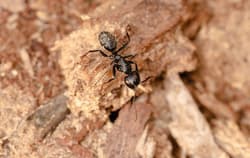Controlling carpenter ants in Western Massachusetts can be simpler than many homeowners anticipate. These ants, known for their wood-boring habits, often cause anxiety and concern due to their potential to damage wooden structures. However, managing their presence can be straightforward and effective with the right knowledge and strategies. Understanding the behavior and habitat of these ants is key to preventing infestations.
In this article, we explore carpenter ant behavior, signs of carpenter ants in your home, and the most effective ant control in your area. Embracing these methods makes dealing with carpenter ants in Western Massachusetts less daunting and more manageable.
Carpenter Ant Behavior: How Carpenter Ant Colonies Function
Carpenter ant colonies are fascinating and complex systems, showcasing remarkable organizational skills and hierarchy. These colonies start with a single queen, who establishes a new nest and begins laying eggs. Over time, these eggs develop into workers, the backbone of the carpenter ant colony. These worker ants are responsible for foraging, expanding the nest, caring for the young, and protecting the colony.
Carpenter ants prefer moist wood to create their nests, which can often lead to structural damage in homes. The social structure within a colony is highly efficient, with ants communicating through pheromones and tactile signals. Understanding this behavior is important for effectively controlling and preventing infestations, as it allows for targeted strategies that disrupt the colony's life cycle and reduce the likelihood of significant damage.
Signs Carpenter Ants Are Chewing On Your Home
Identifying a carpenter ant infestation early on is important if you want to protect your home from extensive damage. The most prominent signs of carpenter ants include visible damage to wood structures, often resembling smooth tunnels and galleries.
These pests prefer moist and decaying wood, making areas with water damage prime targets. Another key indicator is the presence of frass, a mixture of wood shavings and insect parts, which carpenter ants eject from their tunnels.
Spotting live ants, particularly large, black ones, inside your home is a clear sign of an infestation. Also, listen for faint rustling sounds within walls or wooden structures, indicating the movement of these ants.
Regularly inspecting for these signs helps with the early detection and effective management of a carpenter ant infestation, preventing severe structural damage.
The Most Effective Carpenter Ant Control In Western Massachusetts
American Pest Solutions stands at the forefront of providing the most effective carpenter ant treatment in Western Massachusetts. Our approach is comprehensive and tailored to the unique challenges posed by these pests. Utilizing the latest pest control technology, our skilled technicians conduct a thorough inspection to identify the extent and source of the infestation. They follow this by strategically applying environmentally safe treatments that target carpenter ants without harming your home or the surrounding ecosystem.
At American Pest Solutions, we also focus on preventative measures, educating homeowners on best practices to deter future infestations. Our commitment to customer satisfaction and effective results has made us a trusted name in carpenter ant control, ensuring your home remains safe and free from these destructive pests.
Tips To Prevent Carpenter Ants From Coming Back
At American Pest Solutions, renowned for our expertise in carpenter ant removal, we emphasize the importance of proactive measures to prevent these pests from returning. Here are some effective tips:
- Eliminate Moisture Sources: Repair leaky pipes and ensure proper drainage around your home. Carpenter ants are attracted to moisture, so keeping areas dry is crucial.
- Trim Vegetation: Keep branches and bushes trimmed away from your house. Overhanging vegetation can provide ants easy access to your home.
- Store Firewood Properly: Keep firewood stacked away from your house and elevated from the ground to reduce the likelihood of ants nesting in the wood and then migrating to your home.
- Seal Entry Points: Inspect your home for cracks and crevices, especially where utility pipes enter. Seal these openings to prevent ants from entering.
- Regular Inspections: Have routine inspections by professionals like American Pest Solutions. We can spot early signs of a carpenter ant infestation and take prompt action.
Following these tips and professional assistance from American Pest Solutions can put you in the best position to tackle a carpenter ant infestation, ensuring your home remains safe and secure.

